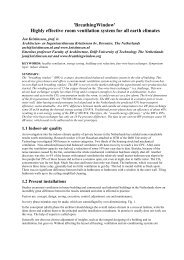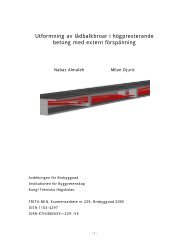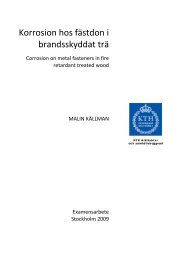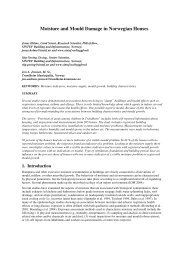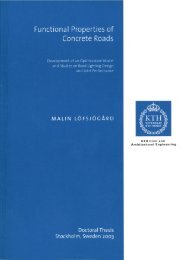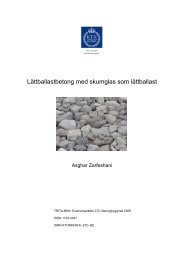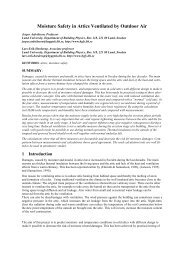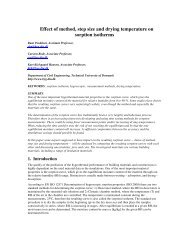Low temperature performance of wax modified mastic asphalt
Low temperature performance of wax modified mastic asphalt
Low temperature performance of wax modified mastic asphalt
You also want an ePaper? Increase the reach of your titles
YUMPU automatically turns print PDFs into web optimized ePapers that Google loves.
Ali Azhar Butt<br />
Graduate Student<br />
Infrastructure Engineering<br />
<strong>Low</strong> <strong>temperature</strong> <strong>performance</strong> <strong>of</strong><br />
<strong>wax</strong> <strong>modified</strong> <strong>mastic</strong> <strong>asphalt</strong><br />
Division <strong>of</strong> Highway and Railway Engineering<br />
School <strong>of</strong> Architecture and the Built Environment<br />
Royal Institute <strong>of</strong> Technology (KTH)<br />
SE- 100 44 Stockholm<br />
aabutt@kth.se<br />
Abstract: The current interest in energy saving <strong>asphalt</strong> production techniques is great and several<br />
new processes have been developed to reduce the mixing and compaction <strong>temperature</strong>s for hot mix<br />
<strong>asphalt</strong>. In particular, <strong>mastic</strong> <strong>asphalt</strong> products (Guss<strong>asphalt</strong>) require high working <strong>temperature</strong>s, and<br />
harder requirements concerning bitumen fumes and carbon dioxide emissions have been introduced<br />
for such products. Consequently, the need <strong>of</strong> a new means <strong>of</strong> producing and placing <strong>mastic</strong> <strong>asphalt</strong> at<br />
lower <strong>temperature</strong>s is particularly large.<br />
One way <strong>of</strong> reducing <strong>asphalt</strong> mixture <strong>temperature</strong> is by using special flow improving additives like<br />
<strong>wax</strong>. This technique has successively been tried in several studies for polymer <strong>modified</strong> <strong>mastic</strong> <strong>asphalt</strong><br />
used for bridge decks and parking areas in Sweden. However, there still are uncertainties about<br />
possible negative impact on crack susceptibility at lower <strong>temperature</strong>s due to the addition <strong>of</strong> <strong>wax</strong>.<br />
In this study, 4% montan <strong>wax</strong> (Asphaltan A) was used for one particular polymer <strong>modified</strong> <strong>mastic</strong><br />
<strong>asphalt</strong> product. Type and amount <strong>of</strong> <strong>wax</strong> additive was selected based on results from earlier studies.<br />
The impact on binder, binder/filler mixtures and <strong>mastic</strong> <strong>asphalt</strong> from production was tested in the<br />
laboratory, focusing on low <strong>temperature</strong> <strong>performance</strong>. The bending beam rheometer (BBR) was used<br />
for determining low <strong>temperature</strong> creep compliance and the tensile stress restrained specimen test<br />
(TSRST) for determining fracture <strong>temperature</strong>s. Binder properties were determined using dynamic<br />
mechanical analysis (DMA), Fourier transform infrared (FTIR) spectroscopy and conventional tests<br />
(s<strong>of</strong>tening point, penetration, elastic recovery, Fraass breaking point, viscosity and storage stability).<br />
Aging was performed using the rolling thin film oven test (RTFOT) at 200°C.
As expected, the addition <strong>of</strong> <strong>wax</strong> to the polymer <strong>modified</strong> binder showed a viscosity reduction at<br />
higher <strong>temperature</strong>s, corresponding to a similar positive effect <strong>of</strong> more than 10°C on production and<br />
laying <strong>temperature</strong> for the <strong>mastic</strong> <strong>asphalt</strong>. DMA and BBR results showed some increase in stiffness<br />
and a more elastic response <strong>of</strong> the <strong>wax</strong> <strong>modified</strong> binder at medium and low <strong>temperature</strong>s. The TSRST<br />
fracture <strong>temperature</strong> was 5 °C higher for the <strong>mastic</strong> <strong>asphalt</strong> containing 4% <strong>wax</strong>, indicating however<br />
no dramatic negative impact on crack susceptibility.<br />
KEY WORDS: montan <strong>wax</strong>; <strong>modified</strong> binders; <strong>mastic</strong> <strong>asphalt</strong>; TSRST; energy saving; low <strong>temperature</strong><br />
<strong>performance</strong>



